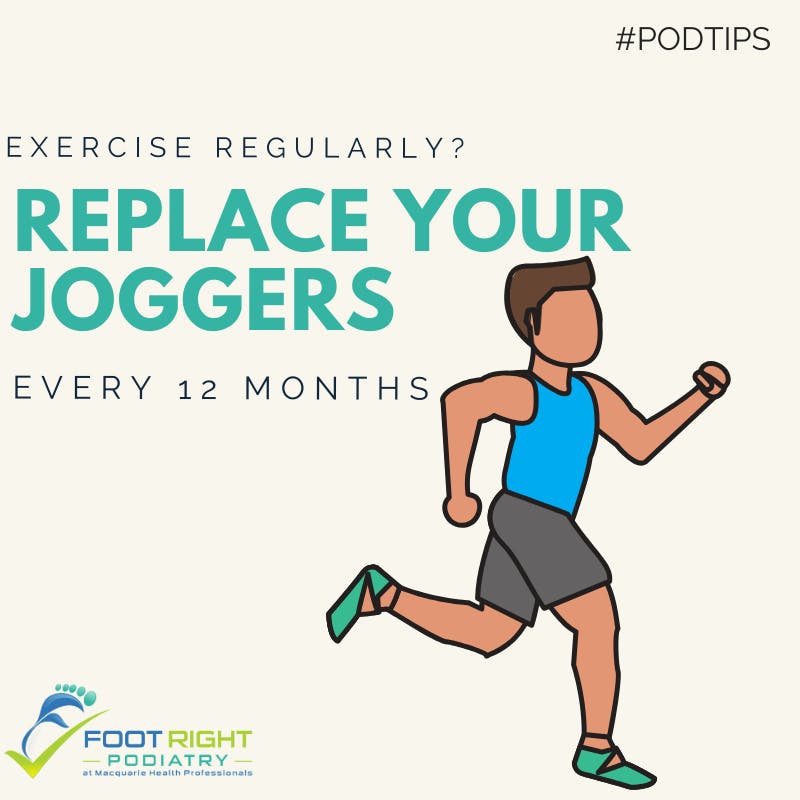Replace your Joggers every 12 months

As a podiatrist, I see countless patients who arrive with injuries and chronic pain that could have been avoided with one simple change: replacing their athletic footwear on time. While it’s easy to get attached to a favourite pair of running shoes or trainers, wearing shoes beyond their lifespan can significantly impact your foot health and performance.
In this post, I’ll explain why it’s important to replace your athletic footwear regularly and how failing to do so can lead to preventable injuries.
The Hidden Risks of Worn-Out Footwear
Athletic shoes are designed with specific cushioning, support, and grip to protect your feet and enhance performance during activity. However, these components degrade over time due to:
- Repeated Impact: Every step you take compresses the cushioning, reducing its shock-absorbing properties.
- Structural Fatigue: The midsole, which provides essential support, loses its effectiveness over time.
- Outer Wear: The outsole (the bottom of the shoe) wears down, reducing grip and increasing the risk of slips and falls.
When your shoes deteriorate, they can no longer support your feet properly. This misalignment places undue stress on your muscles, joints, and ligaments, potentially causing:
- Plantar fasciitis
- Achilles tendinitis
- Stress fractures
- Shin splints
- Pain in the knees, hips, or lower back
Signs Your Athletic Shoes Need Replacing
There’s no universal rule for when you should replace your athletic shoes, but here are some key indicators:
- Visible Wear on the Outsole
Check the bottom of your shoes. If the tread is smooth or worn unevenly, it’s time for a new pair. Uneven wear can also point to biomechanical issues like overpronation or supination. - Decreased Cushioning
If your shoes feel flat or less springy, the cushioning in the midsole has likely compressed. This can significantly reduce shock absorption. - Pain or Discomfort
Experiencing foot, ankle, or leg pain during or after activity often means your shoes are no longer providing the support you need. - Distance Covered
Most running or athletic shoes are designed to last between 500 and 800 kilometres, depending on your activity level, body weight, and the shoe’s construction. If you’ve reached this range, it’s time for a replacement, even if the shoes look fine on the outside. - Loss of Structure
A quick test: bend the shoe in half. If it flexes too easily or lacks structure, it’s no longer providing adequate support.
The Importance of Timely Replacement
Wearing shoes past their lifespan can create a chain reaction of injuries. Here’s why:
- Inadequate Cushioning increases impact forces on your joints, leading to overuse injuries.
- Poor Support fails to align your foot correctly, straining muscles and tendons.
- Worn Traction heightens the risk of slips, trips, and ankle sprains.
Replacing your athletic footwear regularly is not just about comfort—it’s about preventing injuries that could keep you sidelined for weeks or months.
Tips for Choosing and Maintaining Athletic Footwear
- Buy Shoes Suited to Your Activity
Running shoes, for example, are constructed differently from those designed for court sports or cross-training. Wearing the right type of shoe is essential for optimal support and performance. - Prioritise Fit and Comfort
Shoes should feel comfortable from the moment you try them on. Don’t rely on the idea of "breaking them in." - Alternate Between Pairs
If you’re active frequently, consider rotating between two pairs of shoes. This allows the cushioning to recover and extends the lifespan of each pair. - Track Your Kilometres
Use a fitness tracker or app to log the distance you’ve covered in your running or walking shoes. Replace them once you hit the 500–800 km mark. - Store Shoes Properly
Keep your shoes in a cool, dry place. Avoid leaving them in hot or damp environments, such as a car boot, as this can accelerate material breakdown.
Final Thoughts
As someone who frequently treats injuries caused by deteriorated footwear, I cannot overstate the importance of replacing your athletic shoes regularly. Your feet are your foundation, and taking care of them starts with wearing the right shoes in good condition.
Don’t wait until discomfort or injury forces you to take action. If you’re unsure whether it’s time to replace your shoes or need help selecting the right pair, book an appointment. Together, we can keep you active, healthy, and free from preventable injuries!